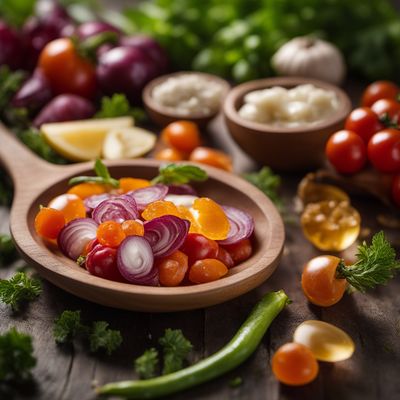
Ingredient
Candied or sugar preserved vegetables
Sweet and Savory Delights: The Art of Candied or Sugar Preserved Vegetables
Candied or sugar preserved vegetables are made by immersing vegetables in a sugar syrup or coating them with sugar, resulting in a sweet and slightly crunchy texture. The vegetables retain their natural flavors while being infused with a subtle sweetness. The sugar syrup acts as a preservative, extending the shelf life of the vegetables and intensifying their flavors. The preserved vegetables can range from tender and slightly crisp to chewy, depending on the cooking time and the type of vegetable used. They come in a variety of vibrant colors, adding visual appeal to dishes.
Origins and history
The practice of preserving vegetables in sugar dates back centuries and can be found in various cultures around the world. In China, candied vegetables have been a part of traditional cuisine for centuries, often served as a snack or used in festive dishes. In Western cultures, candied vegetables gained popularity during the Renaissance period, where they were used as decorative elements in elaborate banquets. Over time, the technique of preserving vegetables in sugar has evolved and adapted to different culinary traditions.
Nutritional information
Candied or sugar preserved vegetables provide a concentrated source of energy due to the added sugar. They also retain some of the nutrients present in the original vegetables, such as vitamins and minerals. However, it is important to consume them in moderation due to their high sugar content.
How to select
When selecting candied or sugar preserved vegetables, look for vibrant colors and a glossy appearance. The vegetables should be plump and evenly coated with sugar syrup. Avoid any signs of spoilage, such as mold or off odors. Opt for reputable brands or homemade versions to ensure quality.
Storage recommendations
Store candied or sugar preserved vegetables in airtight containers in a cool, dark place. They can be kept at room temperature for several months, but refrigeration can further extend their shelf life. Ensure that the vegetables are fully submerged in the syrup to prevent spoilage.
How to produce
To produce candied or sugar preserved vegetables at home, start by blanching the vegetables to retain their color and texture. Then, prepare a sugar syrup by dissolving sugar in water and adding flavorings such as spices or citrus zest. Simmer the vegetables in the syrup until they become tender and translucent. Finally, allow the vegetables to cool and store them in sterilized jars with the syrup.
Preparation tips
Candied or sugar preserved vegetables can be enjoyed as a standalone snack or used as a versatile ingredient in both sweet and savory dishes. They can be added to salads, used as toppings for desserts, incorporated into stir-fries, or paired with cheese and charcuterie boards. When using them in recipes, adjust the amount of added sugar accordingly to balance the sweetness.
Culinary uses
Candied or sugar preserved vegetables are commonly used as garnishes for cakes, pastries, and desserts, adding a touch of sweetness and visual appeal. They can also be used in savory dishes such as glazed roasted vegetables, stir-fries, or as a unique addition to salads and sandwiches.
Availability
Candied or sugar preserved vegetables can be found in specialty food stores, gourmet markets, and online retailers. They are commonly available in regions with a strong culinary heritage, such as China, France, and Italy.
More ingredients from this category

Canned/jarred vegetables
Preserved Garden Goodness: Unlocking the Flavorful World of Canned/Jarred Vegetables

Processed tomato products
The Versatile World of Tomato Transformations

Dried vegetables
Preserving Nature's Bounty: Exploring the World of Dried Vegetables

Salted vegetables
Savory Preserved Delights

Fermented or pickled vegetables
Tangy Delights: Fermented and Pickled Vegetables

Vegetable puree or paste
Versatile Veggie Blend